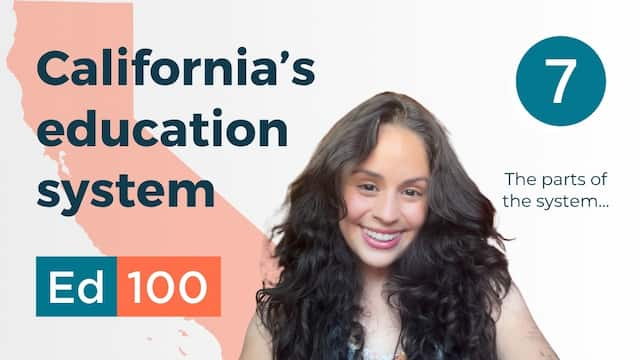
California’s powerful initiative process was added to the state constitution in 1911.
In This Lesson

How do ballot initiatives work in California?
How much money does it cost to get an initiative on the ballot?
How do initiatives make it to the California ballot?
Can initiatives amend the constitution in California?
How have initiatives impacted education in California?
How much money does the lottery bring to California schools?
▶ Watch the video summary
★ Discussion Guide
With money for enough signatures, your idea for change to California law or even to the California constitution can be placed on a statewide ballot.
Paid signatures dominate the initiative process
In principle, the initiative process is about private citizens mobilizing. In practice, collecting signatures that actually matter is directly a function of dollars. Virtually all signatures for successful initiative petitions — over 90% of them — are collected by paid signature-gatherers, who typically earn several dollars per valid signature on their clipboard. (Have you noticed how genuinely they smile when you sign?)
Over 90% of signatures are collected by paid gatherers. In 2024 the average cost of a signature was $15.08
The value of a signature varies from one initiative to the next. If you ask a signature gatherer how much they will be paid for your signature, they are required to tell you. Often, they collect signatures for more than one initiative at a time. In 2024 the average cost per signature was $15.08 according to Ballotpedia.
The signature collection cost of an initiative in California can be several million dollars.
During the 2016 election season the Sacramento Bee featured a recorded phone call to signature gatherers with an update on the price being offered for signatures on various measures.
The California Secretary of State provides directions for qualifying an initiative.
With a majority vote, initiatives can directly amend the state constitution, bypassing the legislative process. When lawmakers want to change the state constitution they also have to get voter approval. To walk in the weeds about the difference between an initiative (bypassing the legislature) and a referendum (placed on the ballot by the legislature) read here.
Prop 13 and more
Initiatives have had an enormous impact on public schools in California. The most famous initiative was Proposition 13 (1978). Popular from the moment of its creation, Proposition 13 demonstrated the potential scope of initiative power. The main appeal of the measure was to limit property taxes but the net effect was to cut the level of school support that came from local property taxes and hand the control of school funding to the state. (See our full Ed100 Lesson on Prop 13.)
In the years that followed Proposition 13′s passage, voters grew frustrated with falling school budgets, which they blamed on legislative failure (Check out our blog post on California's constitution and the right to a quality education). Another initiative, Proposition 98, promised to put a floor under the funding for K-12 schools and community colleges. Prop 98 established a complex formula obligating the legislature to allocate a certain amount of the budget for the support of the education system. (See Chapter 8 for more on the effect of these propositions.)
Other initiatives have had an enormous impact on education in California. For example:
- 1984: Proposition 37 created the State Lottery, with a portion of earnings earmarked for public education. (The lottery delivers about one cent out of every dollar that goes to schools).
- 1990: Proposition 111 amended Proposition 98.
- 1998: Proposition 227 limited non-English instruction. (Voters repealed it in 2016 by passing Proposition 58.)
- 2000: Proposition 39, placed on the ballot by the Legislature, amended a part of Proposition 13 and enabled school districts to pass General Obligation bonds with a 55% vote.
- 2012 and 2016: Propositions 30 (2012) and 55 (2016) added funding for public education. The funding is scheduled to sunset (go away) in 2030.
- 2022: Proposition 28 guaranteed funding for arts education faculty in all schools.
Big Ballots
California Governors Arnold Schwarzenegger (2003-2011) and Jerry Brown (2011-2019) both made heavy use of the ballot box to pass policies into law. While Schwarzenegger was unsuccessful in gaining voter support for his desired reforms, Brown managed to get voters to raise state income and sales taxes in 2012 in order to stabilize the state budget with passage of Proposition 30, renewed as Proposition 55 in 2016.
Important policy in California has frequently been enacted through the ballot, bypassing the legislature, or by the threat of it. At times, governors have turned to initiatives rather than the legislature because the legislative process had proved insurmountable. In 2013, the Public Policy Institute of California released a study that looked at public opinion about initiatives and made policy recommendations.
Among those recommendations: curb the influence of money to put measures on the ballot. Bills to restrict paid signature gathering have reached the Governor's desk and been vetoed at least twice, once by Brown in 2013 (AB 857) and another by Newsom in 2019.
Initiatives, changes in law and other efforts don't arise spontaneously. The next lesson examines the ecosystem of organizations that variously support, inform, critique and cajole to create changes in the system.
This lesson was last updated in December 2024.
CHAPTER 7:
And a System…
-
And a System…
Overview of Chapter 7 -
The Role of State Government in Education
California’s Constitutional Responsibility -
The Federal Government and Education
Small money, Big Influence -
School Districts in California
What do School Districts Do? -
County Offices of Education
Oversight and Regional Services -
Teachers' Unions in California
What do Teacher Unions Do? -
Ballot Initiatives and Education
California's Initiative Process and How It Affects Schools -
Who Influences Education?
Politics, Philanthropy and Policy -
Accountability in Education
Who Monitors the Quality of Schools? -
What to Do with Failing Schools
Interventions and Consequences in California -
The LCAP
Annual Plans for California School Districts
Related
Sharing is caring!
Password Reset
Search all lesson and blog content here.
Login with Email
We will send your Login Link to your email
address. Click on the link and you will be
logged into Ed100. No more passwords to
remember!















Questions & Comments
To comment or reply, please sign in .
Carol Kocivar November 8, 2021 at 9:34 am
The Ca secretary of State provides guide for this:https://elections.cdn.sos.ca.gov/recalls/recall-procedures-guide.pdf
Recall is the power of the voters to remove elected officials before their terms expire. It has been a fundamental part of our governmental system since 1911 and has been used by voters to express their dissatisfaction with their elected representatives.
This publication examines the law of recall as it applies to state and local officials. In some ways, the procedures that apply to the recall of state officials are different from those that apply to local officials. Therefore, this publication is divided into separate parts to help avoid confusion. Be sure to check the Table of Contents to ensure you are referencing the proper procedure.
Jamie Kiffel-Alcheh November 23, 2019 at 3:32 pm
Caryn-C September 7, 2017 at 9:36 am